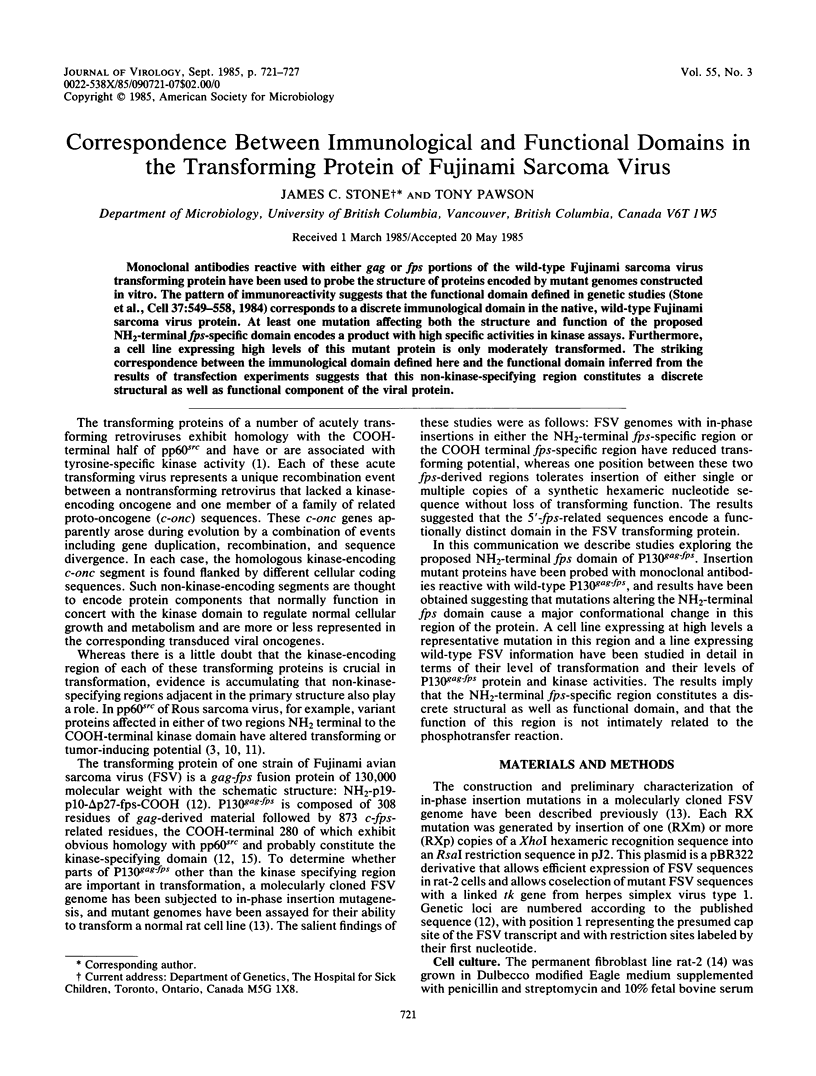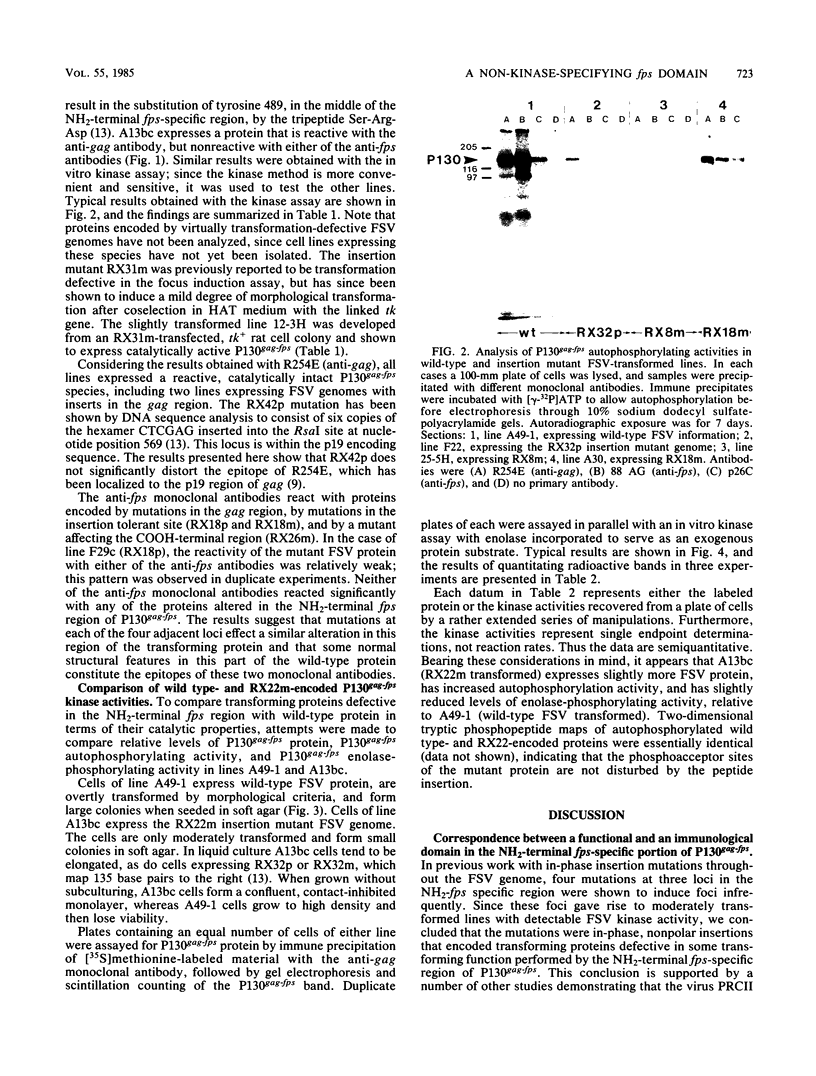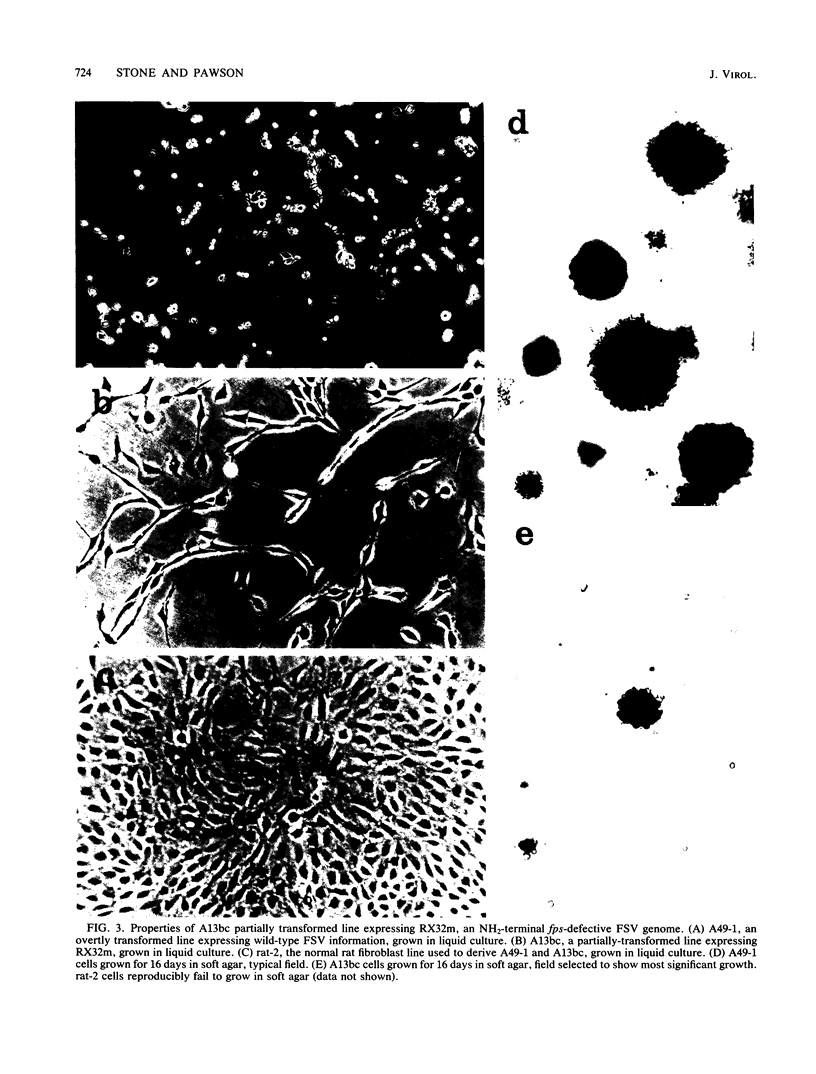Abstract
Monoclonal antibodies reactive with either gag or fps portions of the wild-type Fujinami sarcoma virus transforming protein have been used to probe the structure of proteins encoded by mutant genomes constructed in vitro. The pattern of immunoreactivity suggests that the functional domain defined in genetic studies (Stone et al., Cell 37:549-558, 1984) corresponds to a discrete immunological domain in the native, wild-type Fujinami sarcoma virus protein. At least one mutation affecting both the structure and function of the proposed NH2-terminal fps-specific domain encodes a product with high specific activities in kinase assays. Furthermore, a cell line expressing high levels of this mutant protein is only moderately transformed. The striking correspondence between the immunological domain defined here and the functional domain inferred from the results of transfection experiments suggests that this non-kinase-specifying region constitutes a discrete structural as well as functional component of the viral protein.
Full text
PDF






Images in this article
Selected References
These references are in PubMed. This may not be the complete list of references from this article.
- Bishop J. M. Cellular oncogenes and retroviruses. Annu Rev Biochem. 1983;52:301–354. doi: 10.1146/annurev.bi.52.070183.001505. [DOI] [PubMed] [Google Scholar]
- Breitman M. L., Neil J. C., Moscovici C., Vogt P. K. The pathogenicity and defectiveness of PRCII: a new type of avian sarcoma virus. Virology. 1981 Jan 15;108(1):1–12. doi: 10.1016/0042-6822(81)90522-5. [DOI] [PubMed] [Google Scholar]
- Bryant D., Parsons J. T. Site-directed mutagenesis of the src gene of Rous sarcoma virus: construction and characterization of a deletion mutant temperature sensitive for transformation. J Virol. 1982 Nov;44(2):683–691. doi: 10.1128/jvi.44.2.683-691.1982. [DOI] [PMC free article] [PubMed] [Google Scholar]
- Cooper J. A., Esch F. S., Taylor S. S., Hunter T. Phosphorylation sites in enolase and lactate dehydrogenase utilized by tyrosine protein kinases in vivo and in vitro. J Biol Chem. 1984 Jun 25;259(12):7835–7841. [PubMed] [Google Scholar]
- Duesberg P. H., Phares W., Lee W. H. The low tumorigenic potential of PRCII, among viruses of the Fujinami sarcoma virus subgroup, corresponds to an internal (fps) deletion of the transforming gene. Virology. 1983 Nov;131(1):144–158. doi: 10.1016/0042-6822(83)90541-x. [DOI] [PubMed] [Google Scholar]
- Foster D. A., Hanafusa H. A fps gene without gag gene sequences transforms cells in culture and induces tumors in chickens. J Virol. 1983 Dec;48(3):744–751. doi: 10.1128/jvi.48.3.744-751.1983. [DOI] [PMC free article] [PubMed] [Google Scholar]
- Guyden J. C., Martin G. S. Transformation parameters of chick embryo fibroblasts transformed by Fujinami, PRCII, PRCII-p, and Y73 avian sarcoma viruses. Virology. 1982 Oct 15;122(1):71–83. doi: 10.1016/0042-6822(82)90378-6. [DOI] [PubMed] [Google Scholar]
- Huang C. C., Hammond C., Bishop J. M. Nucleotide sequence of v-fps in the PRCII strain of avian sarcoma virus. J Virol. 1984 Apr;50(1):125–131. doi: 10.1128/jvi.50.1.125-131.1984. [DOI] [PMC free article] [PubMed] [Google Scholar]
- Ingman-Baker J., Hinze E., Levy J. G., Pawson T. Monoclonal antibodies to the transforming protein of Fujinami avian sarcoma virus discriminate between different fps-encoded proteins. J Virol. 1984 May;50(2):572–578. doi: 10.1128/jvi.50.2.572-578.1984. [DOI] [PMC free article] [PubMed] [Google Scholar]
- Kitamura N., Yoshida M. Small deletion in src of Rous sarcoma virus modifying transformation phenotypes: identification of 207-nucleotide deletion and its smaller product with protein kinase activity. J Virol. 1983 Jun;46(3):985–992. doi: 10.1128/jvi.46.3.985-992.1983. [DOI] [PMC free article] [PubMed] [Google Scholar]
- Krueger J. G., Garber E. A., Goldberg A. R., Hanafusa H. Changes in amino-terminal sequences of pp60src lead to decreased membrane association and decreased in vivo tumorigenicity. Cell. 1982 Apr;28(4):889–896. doi: 10.1016/0092-8674(82)90068-x. [DOI] [PubMed] [Google Scholar]
- Shibuya M., Hanafusa H. Nucleotide sequence of Fujinami sarcoma virus: evolutionary relationship of its transforming gene with transforming genes of other sarcoma viruses. Cell. 1982 Oct;30(3):787–795. doi: 10.1016/0092-8674(82)90283-5. [DOI] [PubMed] [Google Scholar]
- Stone J. C., Atkinson T., Smith M., Pawson T. Identification of functional regions in the transforming protein of Fujinami sarcoma virus by in-phase insertion mutagenesis. Cell. 1984 Jun;37(2):549–558. doi: 10.1016/0092-8674(84)90385-4. [DOI] [PubMed] [Google Scholar]
- Topp W. C. Normal rat cell lines deficient in nuclear thymidine kinase. Virology. 1981 Aug;113(1):408–411. doi: 10.1016/0042-6822(81)90168-9. [DOI] [PubMed] [Google Scholar]
- Weinmaster G., Hinze E., Pawson T. Mapping of multiple phosphorylation sites within the structural and catalytic domains of the Fujinami avian sarcoma virus transforming protein. J Virol. 1983 Apr;46(1):29–41. doi: 10.1128/jvi.46.1.29-41.1983. [DOI] [PMC free article] [PubMed] [Google Scholar]






